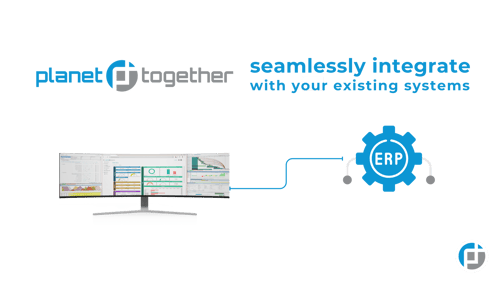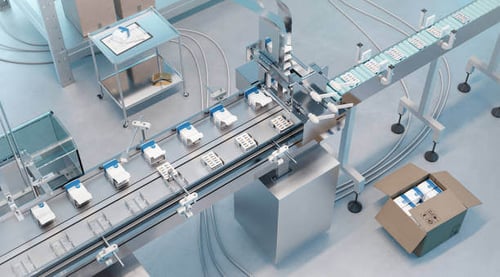Flexibility in Production Planning: A Critical Capability for Medical Manufacturing Schedulers
In medical manufacturing, where patient safety, regulatory compliance, and market demands intersect, flexibility in production planning is not just a competitive advantage—it’s a strategic imperative. Production Schedulers working in medical manufacturing facilities face a unique set of challenges, from managing strict quality controls to responding to fluctuating demand for life-saving devices and medications. In this dynamic environment, rigid scheduling systems and siloed data can create inefficiencies, bottlenecks, and compliance risks.
That’s where Advanced Planning and Scheduling (APS) tools like PlanetTogether come in. Especially when integrated with ERP systems such as SAP, Oracle, Microsoft Dynamics, Kinaxis, or Aveva, PlanetTogether empowers production schedulers with real-time data, predictive capabilities, and the agility required to navigate an increasingly volatile landscape.
Why Flexibility is Essential in Medical Manufacturing
Demand Volatility and Forecast Uncertainty
The demand for medical products is often unpredictable. Whether it’s driven by seasonal trends, public health emergencies, or evolving treatment protocols, sudden spikes or drops in demand can disrupt even the most meticulously crafted production plans. Schedulers must be able to adapt production lines quickly—reprioritizing jobs, reallocating resources, and adjusting schedules without compromising compliance or efficiency.
Regulatory Requirements and Quality Assurance
Compliance with regulatory bodies like the FDA or EMA requires stringent documentation, traceability, and quality control throughout the production lifecycle. Any changes in the production schedule—such as switching batches or adjusting equipment usage—must maintain alignment with regulatory constraints. This adds complexity to planning and demands tools that enable rapid yet traceable adjustments.
Capacity Constraints and Resource Optimization
Many medical manufacturing facilities operate under tight capacity constraints. Specialized machinery, cleanrooms, and skilled labor are not always readily scalable. Flexibility means being able to dynamically reroute production, utilize alternate machines, or adjust shift schedules to meet delivery deadlines—without wasting valuable resources or incurring penalties.

The Role of PlanetTogether in Enabling Flexibility
PlanetTogether’s APS platform is specifically designed to offer the level of granular control, visibility, and adaptability required in a medical manufacturing setting. Unlike traditional scheduling approaches—often reliant on static spreadsheets or disconnected ERP systems—PlanetTogether provides a real-time, constraint-based scheduling environment where production schedules can be simulated, optimized, and adapted continuously.
Key features that support flexibility include:
Real-Time Visibility: Instantly view the status of every production line, resource, and order.
Scenario Planning: Test the impact of production changes before making them live.
Automatic Rescheduling: Use intelligent algorithms to re-sequence production based on new constraints or priorities.
What-If Analysis: Explore alternative schedules to evaluate best-case and worst-case scenarios.
Alerts and Notifications: Stay ahead of delays or resource conflicts with proactive alerts.

Integration with SAP, Oracle, Microsoft, Kinaxis, and Aveva
The power of PlanetTogether multiplies when integrated with your existing ERP, MES, or SCM platform. A production scheduler’s ability to respond flexibly depends on having accurate, up-to-date data from across the operation—and that’s exactly what integration delivers.
Let’s explore how integration works in practice:
SAP + PlanetTogether: Synchronized Data Flow for Agile Decision-Making
SAP is widely used in medical manufacturing for managing procurement, inventory, and compliance. When PlanetTogether is integrated with SAP:
Material availability is automatically considered in the schedule.
Batch traceability and compliance data flow seamlessly between systems.
Work order changes in SAP are reflected in PlanetTogether in real-time.
Schedulers can adapt plans instantly without logging into multiple systems.
Oracle + PlanetTogether: Enabling Constraint-Based Scheduling
With Oracle’s comprehensive ERP capabilities and PlanetTogether’s powerful scheduling engine, production schedulers gain:
Constraint-based scheduling that aligns with real-time inventory and capacity data.
Enhanced visibility into downstream and upstream impacts of schedule changes.
Smooth synchronization of quality control checkpoints within production workflows.
Microsoft Dynamics + PlanetTogether: Unified User Experience
Microsoft Dynamics offers a user-friendly interface and deep business process integration. When connected to PlanetTogether:
Schedule updates can be viewed directly from Dynamics dashboards.
Cloud-based synchronization supports remote scheduling and collaboration.
Multi-site scheduling across global operations becomes more manageable.
Kinaxis + PlanetTogether: End-to-End Supply Chain Agility
Kinaxis excels in supply chain visibility and planning. Integrating PlanetTogether allows schedulers to:
Align production plans with broader supply chain signals.
Re-prioritize manufacturing tasks based on supply chain disruptions or inventory buffers.
Create closed-loop feedback between supply chain strategy and shop-floor execution.
Aveva + PlanetTogether: Bridging OT and IT
Aveva focuses on industrial operations and MES platforms. Through integration:
Production data from the shop floor (machine states, process variables) informs scheduling decisions.
Downtime and maintenance data are accounted for in real-time.
Schedulers can optimize uptime while minimizing compliance risks.

Taking the First Step Toward Flexible Planning
If your current scheduling process involves manually juggling spreadsheets, toggling between disconnected systems, or reacting to disruptions with trial-and-error methods, it’s time to reconsider your approach. The stakes in medical manufacturing are simply too high.
By integrating PlanetTogether APS with your existing infrastructure—be it SAP, Oracle, Microsoft Dynamics, Kinaxis, or Aveva—you unlock a new realm of production flexibility. This isn’t about overhauling your operation overnight. It’s about incremental improvements that deliver real, measurable outcomes.
Start with these actions:
Assess Integration Readiness: Collaborate with your IT department to evaluate how your current ERP or MES platforms can connect with PlanetTogether. Most integrations can be configured with minimal disruption.
Pilot a Single Line or Product: Choose a production line or product family that frequently faces scheduling challenges and pilot PlanetTogether’s optimization capabilities there.
Train for Scenario Planning: Empower schedulers with training on “what-if” analysis, automated rescheduling, and visualization tools to make confident decisions on the fly.
Measure What Matters: Track KPIs like schedule adherence, lead time reduction, cleanroom utilization, and changeover frequency to prove ROI and identify areas for refinement.
Future-Proofing Your Facility
Medical manufacturing is evolving fast. Personalized medicine, rapid diagnostics, and biotech innovations are shortening product life cycles and increasing production variability. Meanwhile, global regulatory pressures and supply chain volatility continue to mount.
Future-ready production planning isn’t just about surviving these trends—it’s about thriving through them.
With a flexible planning system in place, you’ll be able to:
Launch new products faster without disrupting ongoing operations.
Respond to component shortages with smart rescheduling—not emergency escalations.
Minimize scrap and rework by ensuring quality constraints are embedded in the production logic.
Maintain full compliance and audit-readiness, even amid last-minute schedule changes.
As a Production Scheduler, you’re already at the center of your plant’s decision-making matrix. With the right tools, you can also become its most agile and strategic operator.
Medical manufacturing demands a higher standard of care—and so should your production planning. When flexibility is built into your scheduling process, you gain the power to:
React fast to market and regulatory changes
Optimize resource usage across constrained environments
Maintain production quality and regulatory compliance
Deliver on-time, every time—without firefighting
PlanetTogether, integrated with platforms like SAP, Oracle, Microsoft Dynamics, Kinaxis, or Aveva, brings all this to life in a seamless, data-driven workflow. And for Production Schedulers like you, that means less time troubleshooting and more time proactively steering production success.
Ready to bring flexibility to your scheduling process? Contact us today to learn more about how PlanetTogether can help you achieve your goals and drive success in your industry.
Topics: PlanetTogether Software, Integrating PlanetTogether, Medical Manufacturing, Synchronized Data Flow for Agile Decision-Making, Enabling Constraint-Based Scheduling, Unified User Experience, End-to-End Supply Chain Agility, Bridging OT and IT





















LEAVE A COMMENT